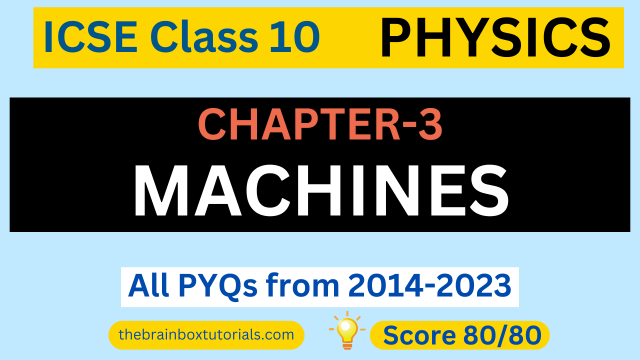The Brainbox Tutorials has especially made the chapter wise PYQs series of all important subjects. Get access to ICSE Class 10 Physics Chapter Machines PYQs + Solution here. All the questions which came in Board exams from the chapter Machines from the year 2014 to 2024 are provided below. Chapter wise PYQs will be very beneficial for the students preparing for the upcoming board exams.
ICSE Class 10 Physics Chapter Machines PYQs + Solution
2024
Q1. Which of the following is a class IIl lever?
(a) Pair of scissors
(b) Wheelbarrow
(c) Crowbar
(d) Human forearm
Ans: (d) Human forearm
Q2. Name the class of the lever shown in the picture below:
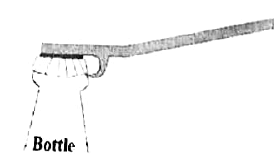
Ans: Class II lever
Q3. Meera chose to use a block and tackle system of 9 pulleys instead of a single movable
pulley to lift a heavy load.
(a) What is the advantage of using a block and tackle system over a single movable
pulley?
(b) Why should she connect more number of pulleys in the upper fixed block?
Ans: (a) In case of block and tackle system of 9 pulleys, the Mechanical Advantage is 9 and it increases with the increase in the number of pulleys in the upper block whereas, in a single movable pulley Mechanical advantage is always 2.
(b) She should connect more number of pulleys in the upper fixed block to increase the Mechanical Advantage.
Q4. Given are two pulleys.
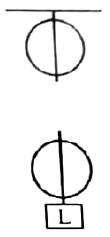
(a) Copy and complete the labelled diagram connecting the two
pulleys with a tackle to obtain Velocity Ratio = 2.
(b) If Load = 48 kg f and efficiency is 80% then calculate:
1. Mechanical Advantage.
2. Effort needed to lift the load.
Ans: (a) Below is the complete diagram connecting the two
pulleys with a tackle:

(b) 1. Efficiency = Mechanical advantage/ Velocity ratio
80% = M.A./ 2
M.A. = 0.8 x 2 = 1.6
2. M.A. = Load/ Effort
1.6 = 48 kg f/ Effort
Effort = 48/1.6
= 30 kg f
2023
Q 5. (a) Name a single pulley in which displacement of load and effort is not the same.
(b) State one advantage of this pulley.
Ans: (a) Single movable pulley
(b) It is used as a force multiplier. It allows for a smaller effort to lift a heavier load.
Q 6. A block and tackle system of pulleys has velocity ratio 4.
(a) Draw a labelled diagram of the system indicating clearly, the direction of the load and the effort.
(b) What is the value of the mechanical advantage of the given pulley system if it is an ideal pulley system?
Ans: (a) The labelled diagram of the system of block and tackle system of pulleys is shown indicating clearly the points of application and direction of load and effort.
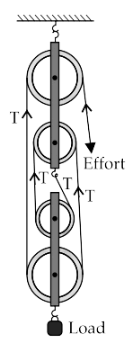
(b) Given: Velocity ratio (V.R.) = 4, Load = 4T, Effort = T
Mechanical advantage (M.A.) = Load/Effort
=4T/T
=4
Hence, the mechanical advantage of the given pulley system is 4.
2021 Semester-1
Q 7. A woman draws water from a well using a fixed pulley. The mass of the bucket and the water together is 10 kg. The force applied by the woman is 200 N. The mechanical advantage is (g = 10 m s-2):
(a) 2
(b) 20
(c) 0.05
(d) 0.5
Ans: (d) 0.5
M.A. = Load/ Effort
= 10 x 10/ 200
= ½ = 0.5
Q 8. A single fixed pulley is used because:
(a) it changes the direction of applied effort conveniently.
(b) it multiplies speed.
(c) it multiplies effort.
(d) its efficiency is 100%.
Ans: (a) it changes the direction of applied effort conveniently.
Q 9. In the diagram shown below, the velocity ratio of the arrangement is:

(a) 1
(b) 2
(c) 3
(d) 0
Ans: (b) 2
Velocity ratio = distance moved by effort/distance moved by Velocity
2T = L
T = L/2 = E
L = 2 E
For twice the distance moved by effort, load will move once
Velocity ratio = 2
2020
Q 10. A block and tackle system of pulleys has velocity ratio 4.
(i) Draw a neat labelled diagram of the system indicating clearly the points of application and direction of load and effort.
(ii) What will be its V.R. if the weight of the movable block is doubled?
Ans: (i) Drawn below is the labelled diagram of the system indicating clearly the points of application and direction of load and effort:

(ii) Increase in weight of movable block does not affect velocity ratio. Therefore, V.R. = 4.
Q 11. (i) Identify the class of the lever shown in the diagram below:
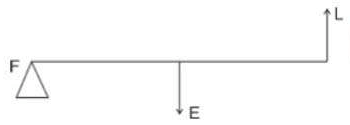
(ii) How is it possible to increase the M.A. of the above lever without increasing its length?
Ans: (i) Class lll lever
(ii) M.A. = Effort am/Load arm.
Its M.A. can be increased by shifting the Effort (E) towards the Load (L). Thus, by increasing the effort arm.
2019
Q 12. The diagram below shows a claw hammer used to remove a nail:
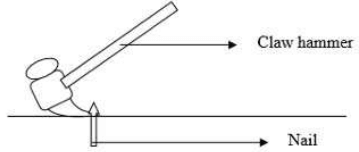
(i) To which class of lever does it belong?
(ii) Give one more example of the same class of lever mentioned by you in (i) for which the mechanical advantage is greater than one.
Ans: (i) Class One.
(ii) Shears used for cutting the thin metal sheets.
Q 13. The diagram below shows a pulley arrangement:
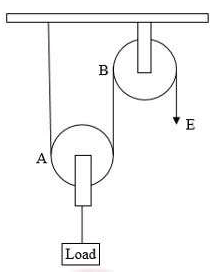
(i) Copy the diagram and mark the direction of tension on each strand of the string.
(ii) What is the velocity ratio of the arrangement?
(iii) If the tension acting on the string is T, then what is the relationship between T and effort E?
(iv) If the free end of the string moves through a distance x, find the distance by which the load is raised.
Ans: (i) The diagram with the direction of tension on each strand of the string is drawn below:
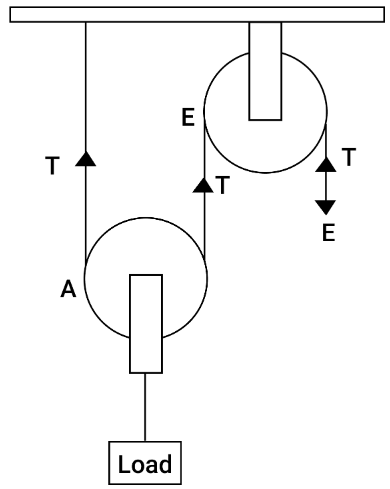
(ii) V.R.= Distance moved by effort/ Distance moved by load =2
(iii) Effort E balances the tensions therefore, T = E
(iv) From the relation,
V.R.= Distance moved by effort/Distance moved by load =2
If the free end of the string moves through a distance x then distance moved by load = ?
Substituting the values we get,
2=x/ Distance moved by load
⇒ Distance moved by load= x/2
2018
Q 14. The diagram below shows a lever in use:
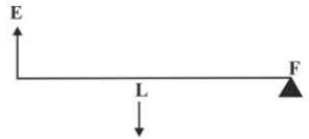
(i) To which class of levers does it belong?
(ii) Without changing the dimensions of the lever, if the load is shifted towards the fulcrum what happens to the mechanical advantage of the lever?
Ans: (i) Class ll lever
(ii) If the load is shifted towards the fulcrum, load arm will reduce. Hence mechanical advantage of the lever will increase, as
M.A. = effort arm/ load arm
Q 15. (i) Draw a diagram to show a block and tackle pulley system having a velocity ratio of 3 marking the direction of load(L), effort(E) and tension(T).
(ii) The pulley system drawn lifts a load of 150 N when an effort of 60 N is applied. Find its mechanical advantage.
(iii) Is the above pulley system an ideal machine or not?
Ans: (i) The diagram showing a block and tackle pulley system having a velocity ratio of 3 marked with the direction of load(L), effort(E) and tension(T) is given below:
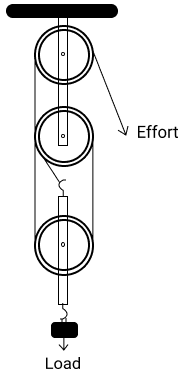
(ii) M.A. = Load/ Effort
= 150/ 60
= 2.5
(iii) No, the pulley system is not an ideal machine as M.A. < V.R
2017
Q 16. Which class of lever will always have MA > 1 and why?
Ans: Class ll lever will always have M.A. > 1. In this type of lever The Load is in between Effort and Fulcrum. Thus the Effort arm is always greater than the Load arm.
Q 17. A boy uses a single fixed pulley to lift a load of 50 Kg f to some height. Another boy uses a single movable pulley to lift the same load to the same height. Compare the effort applied by them. Give a reason to support your answer.
Ans: Load to be lifted = 50 kg f
Case 1: Fixed pulley is used.
MA for single fixed pulley M.A.=1
Thus effort applied by the boy = Load/ M.A.
=50/1
=50 Kg f
Case 2: Movable pulley is used.
MA for movable pulley M.A.= 2
Thus effort applied by the boy = Load/ M.A.
=50/ 2
=25 Kg f
So, effort to be applied by the boy is less in case when he used a movable pulley because MA for a movable pulley is greater than 1.
Q 18. A pulley system with VR = 4 is used to lift a load of 175 kg f through a vertical height of 15 m. The effort required is 50 kg f in the downward direction. (g = 10 N kg-1) Calculate:
(i) Distance moved by the effort.
(ii) Work done by the effort.
(iii) M.A. of the pulley system.
(iv) Efficiency of the pulley system.
Ans: (i) Velocity ratio (VR)= 4
The distance traveled by load (dL) =15 m
The load (L) =175 kg f
The effort (E) =50 kg f
G = 10 N/kg
VR=distance travelled by effort (dE)/ distance travelled by the load (dL)
4 = dE /15
dE = 60 m
Hence, the distance moved by the effort is 60 m.
(ii) Effort done (E)= 50 kg f
= 50×10 N = 500 N
Distance moved by the effort (dE) = 60 m
work done = E x dE.
= 500 N x 60m
= 30000 J
Hence, work done by the effort is 30000 J.
(iii) The load L = 175 kg f
The effort E= 50 kg f
mechanical advantage (M.A.) = L/E
=175/ 50
= 3.5
Hence, the mechanical advantage is 3.5.
(iv) Mechanical advantage MA=3.5
Velocity ratio VR=4
efficiency = M.A./ V.R.
= 3.5/ 4
= 0.875
= 87.5 %
Therefore, the efficiency is 87.5%.
2016
Q 19. With reference to the terms Mechanical Advantage, Velocity Ratio and efficiency of a machine, name and define the term that will not change for a machine of a given design.
Ans: It is velocity ratio that will not change for a machine of given design while mechanical advantage and efficiency can vary according to circumstances.
Definition: Velocity ratio of simple machine is the ratio of distance travelled by the effort to the distance travelled by the load in the machine.
Q 20. (a) From the diagram given below, answer the questions that follow:
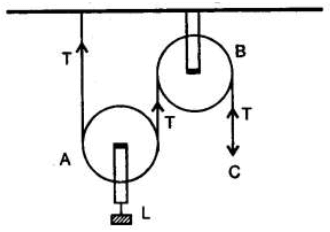
(i) What kind of pulleys are A and B?
(ii) State the purpose of pulley B.
(iii) What effort has to be applied at C to just raise the load L = 20 kg f?
(Neglect the weight of pulley A and friction).
Ans: (i) A – single movable pulley
B – single fixed pulley
(ii) Pulley B changes the direction of the force applied to a convenient direction.
(iii) Given: L= 20 kg f
In equilibrium, L= 2T and Effort E = T
∴ Effort needed, E = L/ 2
=20 kg f/ 2
= 10 kg f
(b) A pulley system has three pulleys. A load of 120N is overcome by applying an effort of 50N. Calculate the Mechanical Advantage and Efficiency of this system.
Ans: Velocity ratio (VR) is equal to the number of pulleys i.e. = 3
L = 120 N and E = 50 N
M.A. = L/ E
= 120 N/ 50 N
= 2.4
The mechanical advantage of the system is 2.4
Efficiency = M.A./ V.R. x 100%
= 2.4/ 3 x 100%
= 80 %
So, the efficiency is 80 % .
2015
Q 21. A block and tackle system has V.R = 5.
(i) Draw a neat labelled diagram of a system indicating the direction of its load and effort.
(ii) Rohan exerts a pull of 150 Kg f. What is the maximum load he can raise with this pulley system if its efficiency = 75%?
(i) The labelled diagram of a system indicating the direction of its load and effort is given below:

(ii) Given: V.R. = 5, L = ?
E = 150 kg f
efficiency η = M.A./ V.R.
⇒ 75%= M.A./ 5
75/100 = M.A./ 5
M.A. = 3.75
Now, M.A. = Load/ Effort
3.75 = Load/ 150
Thus, Load = 3.75 x 150 = 562.5 kgf
2014
Q 22. What is the principle of an ideal machine?
Ans: Principle of an ideal machine: An ideal machine is that in which there is no dissipation of energy in any manner.
In an ideal machine, the work output is equal to the work input, i.e., the efficiency of an ideal machine is 100%.
Q 23. Draw a diagram to show how a single pulley can be used so as to have its ideal M.A = 2.
Ans: The diagram of single movable pulley with M.A.= 2 is given below:
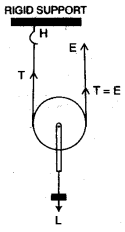
Here Load is supported by 2T
E = T
Hence, M.A. = L/ E = 2T/ T = 2
Q 24. Derive a relationship between mechanical advantage, velocity ratio and efficiency of a machine.
Ans: Let a machine overcome a load L by the application of an effort E.
In time t, let the displacement of effort be dE and the displacement of the load be dL.
Work input = Effort × displacement of effort
= E × dE
Work output = Load × Displacement of load
= L × dL
Efficiency = work output/ work input
L x dL / E x dE = L/ E x dL/ dE
But, Load (L)/ Effort (E) = M.A.
And
dE/ dL = V.R.
Therefore, efficiency = M.A./ V.R.
ICSE Class 10 Physics PYQs + Solution chapterwise
ICSE Related Links
Chapter-wise Quiz/MCQ/Test:
ICSE Chapter wise Quiz For Class 6
ICSE Chapter wise Quiz For Class 7
ICSE Chapter wise Quiz For Class 8
ICSE Chapter wise Quiz For Class 9
ICSE Chapter wise Quiz For Class 10
Sample Papers
Board Papers
ICSE Class 9 Board Exam Papers
ICSE Class 10 Board Exam Papers
CBSE Related Links
Chapter wise Quiz/MCQ/Test
CBSE Chapter-wise Quiz for Class 6
CBSE Chapter-wise Quiz for Class 7
CBSE Chapter-wise Quiz for Class 8
CBSE Chapter-wise Quiz for Class 9
CBSE Chapter-wise Quiz for Class 10
Sample Papers
Board Papers
CBSE Class 10 Previous years’ Board Papers
Subscribe to our YouTube channel for more educational content.

